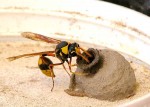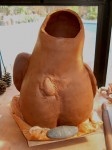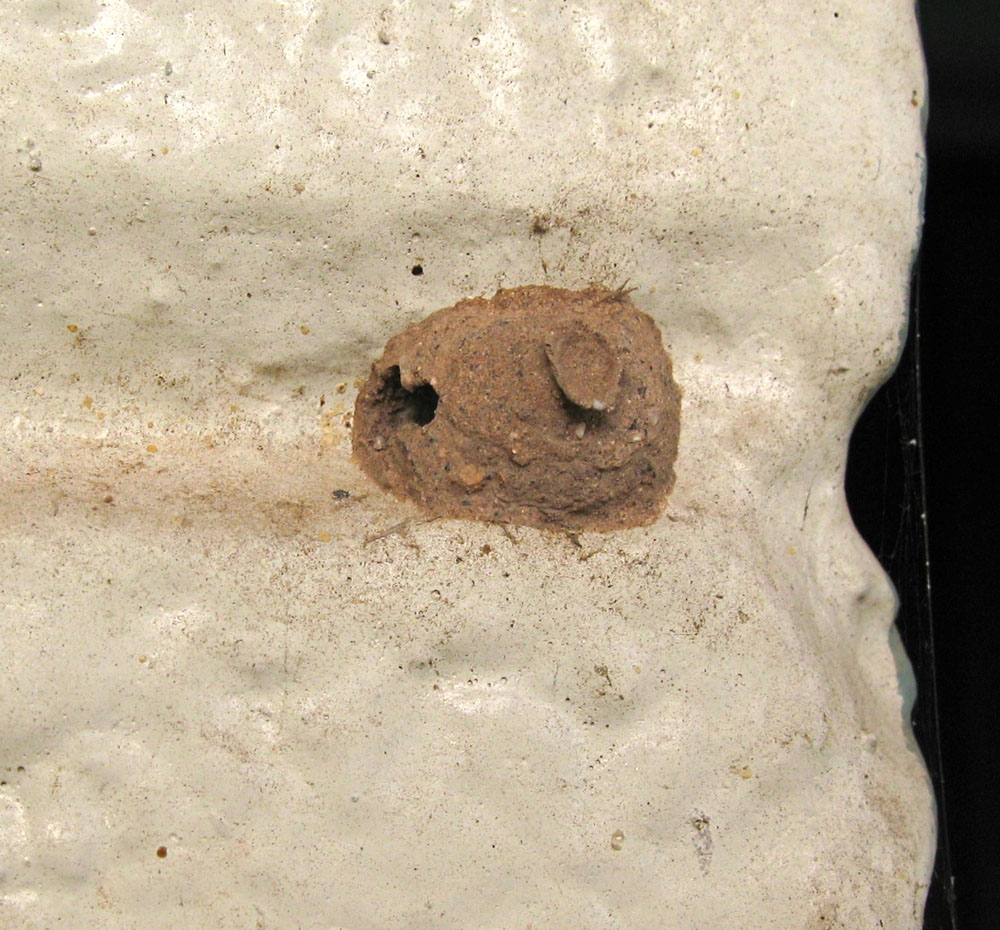Close in — tiny mud pot forms on wall
 Every once in a while, I find a clay pot — a tiny, perfect clay pot — on the wall of the house. They look like little half-buried Mediterranean amphorae, without handles, with a narrow neck and a flared rim, the entire thing only half an inch across. But they have no openings: like the false-necked vessels drachmai-conscious Athenian families left at the graves of loved ones — they looked full of precious oil while only actually containing a thimbleful — these tiny pots are sealed at the top. Sometimes, however, they have a hole in the side, as if a micro-tomb-robber struck the belly of the pot with a spade, to sift through the contents.
Every once in a while, I find a clay pot — a tiny, perfect clay pot — on the wall of the house. They look like little half-buried Mediterranean amphorae, without handles, with a narrow neck and a flared rim, the entire thing only half an inch across. But they have no openings: like the false-necked vessels drachmai-conscious Athenian families left at the graves of loved ones — they looked full of precious oil while only actually containing a thimbleful — these tiny pots are sealed at the top. Sometimes, however, they have a hole in the side, as if a micro-tomb-robber struck the belly of the pot with a spade, to sift through the contents.
A little spadework in books and on the internet turned up the answer to who the tiny potters in our yard might be : Microdynerus arenicolus, the Antioch Potter Wasp, who builds up this mud cell for its offspring one mouthful of clay at a time.
You would think a wasp bringing mouthful after mouthful of mud to a wall right by the front door might be observed easily, but I’ve never knowingly seen one of these wasps on the job. What I can glean about the appearance and habits of the Antioch Potter Wasp is that they are about half-an-inch long, live in California, southern Arizona and New Mexico, and are solitary wasps.  The adults have creamy white or yellow and black markings, and there are subtle differences in coloring and morphology between males and females that are probably mostly important to other wasps and entomologists. (The photo on the left is not our Potter Wasp, it’s a related species from Australia.) The females have stingers, but are “docile”. They are also “domestic”: it’s the female who does all the housework. Here’s what an Arizona Game and Fish document says about the Antioch Potter Wasp:
The adults have creamy white or yellow and black markings, and there are subtle differences in coloring and morphology between males and females that are probably mostly important to other wasps and entomologists. (The photo on the left is not our Potter Wasp, it’s a related species from Australia.) The females have stingers, but are “docile”. They are also “domestic”: it’s the female who does all the housework. Here’s what an Arizona Game and Fish document says about the Antioch Potter Wasp:
These are solitary wasps, each female constructing nests and provisioning them for her own offspring. Each nest looks like a small jug, about half an inch in diameter, with a short sealed neck. When the female decides to make a cell, she selects a sheltered place, and then carries dollops of mud there for construction. This is a precision process with a thin walled pot resulting. When the pot is almost completed, with just room for her to get her head in, she starts to provision the cell with hairless caterpillars, which she has paralyzed by stinging them in the central nervous system. Once the cell is full she lays an egg on the prey and restarts the cell making process. She adds mud to the edges of the nearly spherical pot. Closing the sphere presents problems that are solved by simply adding extra mud and leaving a small neck. The larva that hatches from the egg eats the prey, spins a cocoon inside the pot and pupates. When the new adult is ready to leave the pot, it simply makes a hole in the side and leaves. Using the neck would be logical but that is where the pot is the thickest.
–Arizona Game and Fish Department. 2004. Microdynerus arenicolus. Unpublished abstract compiled and edited by the Heritage Data Management System, Arizona Game and Fish Department, Phoenix, AZ. 4 pp.
Unless you’re a hairless caterpillar, this is a fascinating process. Especially for a potter: the technique of building a pot from the bottom up, adding little bits of clay at a time, and contouring it as you go is exactly the technique potters use to build vessels or vessel-like sculptures. Vessels of any size and shape can be made as long as the supply of moist clay holds out: the potter wasp makes her own by carrying a mouthful of water to a dry clay source and mixing it up to the right consistency and carrying it to the construction site. To the right is a picture of a Three Star Owl VLO (Very Large Owl) being constructed in the same way as a potter wasp builds her nest. (It will be more than two feet tall and at this point lacked its face. Please note that the finished owl sculpture was not provisioned with hairless caterpillars nor were any eggs at all laid during the process.)
the technique of building a pot from the bottom up, adding little bits of clay at a time, and contouring it as you go is exactly the technique potters use to build vessels or vessel-like sculptures. Vessels of any size and shape can be made as long as the supply of moist clay holds out: the potter wasp makes her own by carrying a mouthful of water to a dry clay source and mixing it up to the right consistency and carrying it to the construction site. To the right is a picture of a Three Star Owl VLO (Very Large Owl) being constructed in the same way as a potter wasp builds her nest. (It will be more than two feet tall and at this point lacked its face. Please note that the finished owl sculpture was not provisioned with hairless caterpillars nor were any eggs at all laid during the process.)
I determined to keep an eye on the little wasp-pot, hoping to see a new wasp break free and fly away, to carry on the work of potter wasps in the yard. Of course, the next time I looked, there was the hole, and the empty belly of the tiny clay amphora — the wasp had flown. Here’s a picture of the hole made from the inside out by the wasp itself, not a grave robber after all:
Etymology
The common name, Antioch Potter Wasp, seems like a very appropriately Mediterranean name for an organism that makes structures that look like amphorae, the storage and shipping vessels found all over the Mediterranean region from about the 13th century BC until the 7th century AD. But it’s mere coincidence, and not connected with the ancient city of Antioch on the Levantine coast of the Mediterranean (the stretch of land from which the earliest amphorae, the so-called “Canaanite jars”, come), a hub of commerce and shipping. The species was given its name from the town of Antioch, California, also a hub of commerce and shipping, where the type specimen was collected and described.
(Photos: #1, 3, 4, A.Shock, Three Star Owl. #2, from the following site: http://www.geocities.com/brisbane_wasps/images/MudDau7.jpg, no photo credit found)

I live in Upstate NY near Buffalo and while sweeping my porch, I noticed a strange little mud pot stuck between the cushion and the back of one of my porch chairs. Thanks for solving my little mystery! I have seen them in action on my back deck with the little green worms, but they were going into a hole in a deck light with the prey.
Veronica, my husband told me just yesterday he saw a wasp predate a little green “inchworm” in mid-air, from the end of the small worm’s silk cord as it hung from a palo verde tree. It didn’t occur to me until I read your comment that instead of a predatory wasp capturing lunch for itself, it could have been one of our female potter wasps provisioning a “pot” nest for her larva. So, thanks right back to you, as well!
I live in Pensacola, Florida and I found a little terra cotta pot stuck to one of my socks hanging outside to dry. I was amazed because normally the only thing that gets on clothes is from pesky birds, if you get my drift. This was hollow and looked like it was made from a living creature. I was so amazed that I took 3 photos to show people, and then being afraid it might be a spider’s nest I crushed it on the sidewalk. It sounded like a piece of ceramic breaking. Wow. It really was a terra cotta pot created by something. So I looked it up and I found this. Do you think those wasps live in Florida?
Samantha, I think there are Potter’s wasps (Eumenes spp) where you live. Here’s a link to an informational site specifically about Florida’s potter’s wasps: http://entnemdept.ufl.edu/creatures/misc/wasps/potter_wasps.htm
By the way, I also dry my laundry outside on a line, so I know all about birds and clean clothes! Although, I must say, it happens less often than you’d think… I’ve never had a potter’s wasp build a nest on my drying clothes, though!
Thanks for the link. I feel kind of bad for smushing it. It sounded like I was crushing glass. I don’t mind bees as much as I do spiders. I take a lot of bumblebee photography for my art work. Since I don’t have children yet I don’t have to worry about bee stings. Anyways, thanks for letting me know.
[…] of an un-opened Potter Wasp nest on the front wall of our house, with a drawing pencil for scale. Click here for more info on what these tiny clay pots are, and why the wasps build them. One of these days, I hope to be […]
I found one of these pots on my doorstep today in Seattle, WA. It had three little green inch worms in it that were still alive but would only twitch when disturbed. At first I figured the pot was a wasp nest but the inch worms inside really threw me off. Glad I found this site that so eloquently explained what I found. Thanks!
Pat, glad you found useful info here. I don’t know if your Seattle potters are the same species, but types of potter wasps do seem to live all over the country, and the world. “Our” potter wasps have been very active this summer here in our yard. I’ve finally seen several, catching one in the process of building a little pot on the leaf of a Hoya in a planter hanging on the back porch: they’re brown and yellow and have a very slender, double-jointed looking abdomen. This nest was broken into by a predator — probably a Cactus wren — but I recently found another successful pottery nest near the first, with the single small-bore hole in the side made by the emerging new wasp. I still haven’t been able to capture an emergence on camera, though — or even an adult wasp, though!
We live in Southern California in the greater Los Angeles area. My husband just found a perfect little mud pot with a short neck that was affixed to a wire from which a hummingbird feeder hangs. The little pot broke apart when he removed it from the wire. Inside the pot was a tiny green caterpillar. Thanks to this site, we know what insect was making the pot. This was the first time we have ever seen one of these nesting pots, and we have lived here all our lives.
Cool, Carole! Potter wasps build their nests on protested spots on our house walls all summer, but I’ve only ever seen them either in progress, or after they’ve broken open to release the young wasps.
About a month ago, I saw a wasp just outside the door of the bar that I work at in a shopping mall. He seemed to be eating a piece of chocolate or something sitting on the window ledge. A couple of hours later, I looked and realized that he was building something as the piece had gotten larger rather than smaller. Over the course of a few hours it was completed with the funnel neck that flared at the top. The next day when I went to work, I looked and saw something green inside, it looked like an inch worm or something. The next day…someone had destroyed it, it was broken on the ground.
Yesterday, while smoking outside my job I noticed the same type wasp hovering over the table where I was sitting. He was carrying what looked like an inch worm. He flew under the table. I looked and he flew inside an opening where I thought I could see one of those little pots. I am glad I just googled and found this website. When I go to work on Monday I will get a flashlight and shine it into that opening. Thanks!! Oh and I live on the Big Island of Hawaii.
I just found one of these as well. I’m in New York. It has a green caterpillar inside. Such an interesting find.
I discovered one today. The wasp embryo was half developed and a yellow waxy color. I live 45 minutes north of NYC. I am guilty of destroyimg the clay nest. And feel badly about my actions. It appears to be beneficial and I was plain ignorant. It was stuck to a trellis where I have a potted climbing ivy at the front door. I had a hunch I should not have been so hasty. Thanks for the information. Never again.
Hi Allison 🙂 I live in South-Central Ontario (about an hour west of Toronto). I watched a wasp climbing in and out of the hole in a cube-shaped cigarette snuffer. When I picked up the snuffer, there were 10 (yes, TEN!) of the little green worms, and all were squirming. Am super relieved to have found your website that explains it! Thank you so much!!!
I’m from India and I found this small pot nest on my curtains. First I thought it was just mud but when I looked closer I realised it’s ought to be some insects business because mud doesn’t accumulate in such perfect pot shape. I was so curious and so I Googled it. Thanks to this page I got my answer ….!
But the pot hole doesn’t have any wasp embryo nor does it have any caterpillar. Actually it’s perfectly empty. I’m disappointed I found out too late. I missed the whole fascinating process…!
I was just at a school here in mid Vermont, where I found one of the pots descriptions above. At the time I didn’t know what it was so I broke it open and 4 hairless catipllars fell to the ground.. they wriggled around for about 10 mins and now just lay there unless touched. Interesting. Thank you all for answering my question as to why they were in there.. 👍🏻
I live in Albuquerque, NM, and as I was changing my burned out porch light the other night, I found TWO of these little clay pot nests firmly affixed to the light bulb! I guess this wasp was hoping for a very large family–the two pots were side-by-side! I was fascinated but also afraid that some large, frightening creature would emerge and attack while I was changing the light bulb. Nothing appeared, so I remain unscathed! I asked my friends and neighbors if they had any idea what the pots/nests were, and no one knew. I was thrilled to see this website that explains the mysterious construction project so well! Thank you!
I found one yesterday! In Gujarat, India! 😀
Loved this blog, thanks 🙂
I found one today in Colorado when I pulled apart two stacked planters. Tore the unseen nest in two, green larva were dropping out of it and the mother wasp showed up in a hurry. Had no idea to even look for a mud wasp nest but do now. Backyard plans suspended til mother wasp gets all her larva moved to their new home. Thanks for this page!
We live in northern New Jersey. I found two of these right outside my front door sticking to the door frame. I thought they might be built by ants, but after Googling for information and finding your site, I’m happy to now learn their true origin. Thanks for the great information!
How interesting! I found a whole stack of these tiny amphorae in the almost non-existent gap between my first-floor glass door and its frame, in my house in the Corrèze, in France. I’m afraid I cleared the lot, since we already have too many intruding insects in the house, including, last summer, a plague of wasps. There is a pot of geraniums outside the window, which I water from time to time, so I imagine the materials for potting were conveniently close, for a potter. I am so grateful to know who made these
tiny but perfectly formed pots, thank you!
Lots of these pots all around my apartment complex in the South of Spain Malaga region.